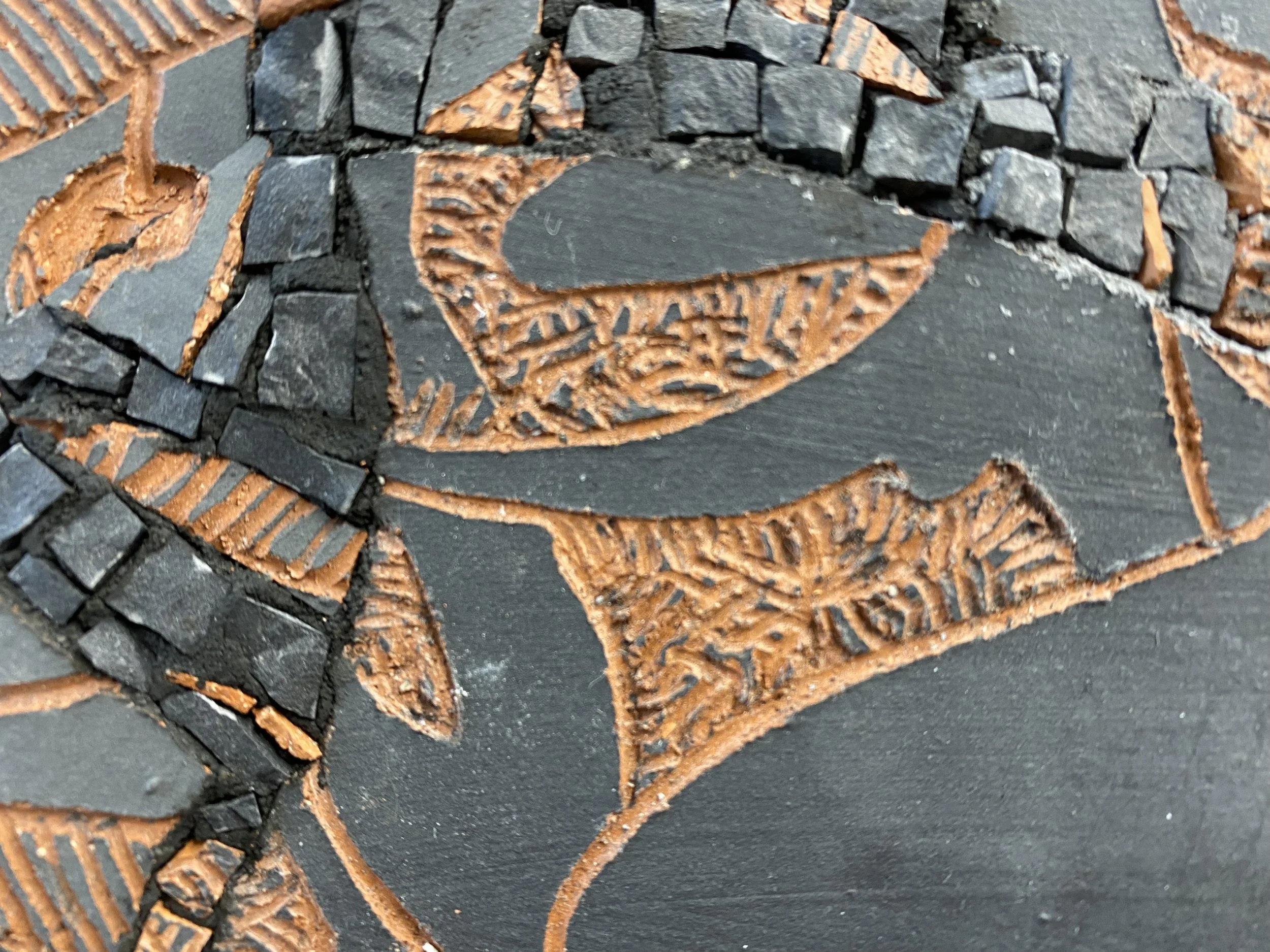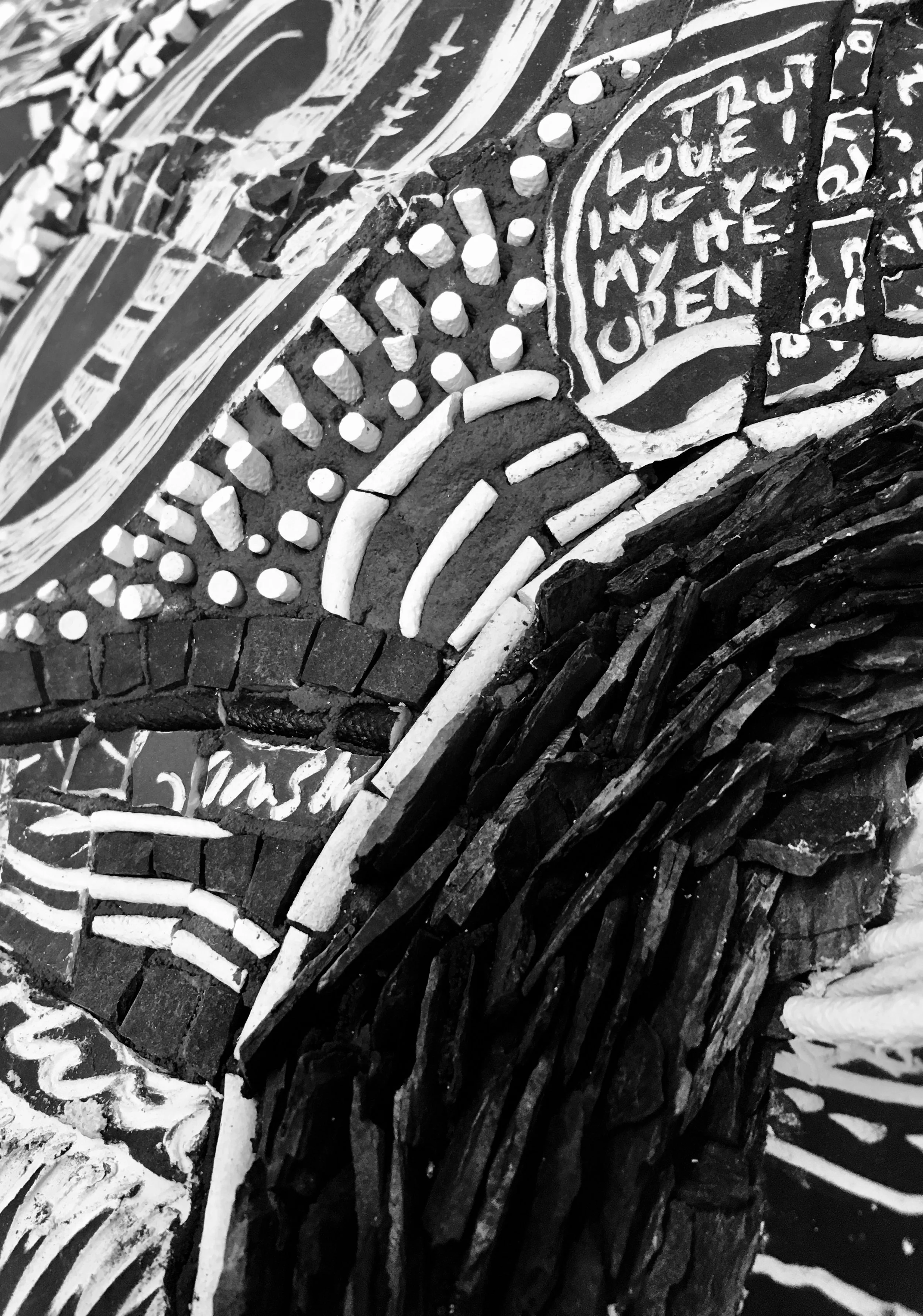November Headtrips
Research rewriting wormholing rollercoaster
Process Blog November 2021
I look at this thesis proposal and I wormhole into every insecurity about my questioning my abilities my purpose in doing this program the pointlessness of art. And then I start digging again. Trying to sort and organize information and find what is relevant and what bits can be discarded. My god… it’s all a fucking mosaic!
How do I understand mosaics...it is an art form and it is a metaphor. Both definitions inform each other. What is the force, the drive, the impetus that brings all these fragments and parts and pieces and scraps together? I don’t want to become a psychologist about this I want to understand the PROCESS of this specific artmaking. I need to CITE the “authorities” on mosaics-ok...makers vs observers? Both?That urge that we, as makers have albeit mosaic, collage, assemblage, bricolage (lots of ‘lages)....to put things together from possibly disassociated fragments or objects and make new- why??? The spaces inbetween THE INTERSTICES the lack of space breathing room mosaic not a skin surface it has shadow and light reflection opacity
Kintsugi-Wabi Sabi-Buddhism It is essentially a concept or ideology that comes from the ‘Buddhist teaching’ of the three marks of existence that are namely “impermanence” (mujō), suffering (ku) and emptiness or absence of self-nature (kū)”.….‘Wabi’ expresses the part of simplicity, impermanence, flaws, and imperfection. On the contrary, ‘Sabi’ displays and expresses the effect that time has on a substance or any object. Together ‘wabi-sabi’ embraces the idea of aesthetic appreciation of aging, flaws, and the beauty of the effects of time and imperfections. The two separate parts when put together, complete each other. They express simplicity and the truest form of an object. Finally, it embraces finding comfort in purity and a life detached from materialistic obsessions of the world. -https://www.kyoto-ryokan-sakura.com/archives/191
I was bothered in a good way by Lisa’s comment that to suggest brokenness would indicate that something was perfect first. This concept is something to examine. If something is broken it may not have been perfect it may have been whole. Broke because it was created imperfectly; flawed. What is flawed? Also she said how it was directly suggestive of craft and pottery specifically. I want to discuss this further
Materials (that clay) is the craft part
Painters have craft parts
The area in art in contemporary that uses THOSE kinds of materials has not been thought out
Clay materiality specific to feel communicate soft and hardness aversion brittleness
The tactility within the process of mosaic- human touch on every single piece, every tesserae.
In clay-the hands in mud, changing forming with hands fingers muscle arms...using touch and the minds eye.
The material- the touching, the tactility- is a YUGE part of this thing. Materialism… is that a thing here? I need to talk to Lisa about this- ceramics, sculpture,
Representation of Trauma in Contemporary Arts by Dumith Kulasekara https://www.athensjournals.gr/humanities/2017-4-1-3-Kulasekara.pdf
I love the examples of artworks to exemplify trauma depiction through visual art. Dumith ois a painter that explores trauma thru color and violent representation. Visceral and emotional, this maybe useful for me to refer to although the process of these artists is unrelated.
“Materialism, the belief that we are nothing more than matter, is typically viewed as antithetical to religious belief; yet an engagement with spirituality has emerged within new materialism. These emerging theories refuse reductive dualisms and emphasise the embodied self in relation to networks of materiality. Matter is viewed not as inert but as agentic (self-determining) (Barad, 2007) and lively (Bennett, 2010), in a dynamic interplay with human actants. This revived transdisciplinary interest in materialism has had a wide impact on contemporary art. The focus on agentic materiality has led to an upsurge of interest in animism, the occult and shamanism. Yet within Western contemporary art, organized religion remains virtually absent, deemed too traditional and conservative in comparison with the progressive and liberal values of art. Curator Anselm Franke states: ‘An invisible background condition of contemporary art still valid today is that it stands outside of faith-based practices, only citing them at most. The historical break with religion continues’ “(2013:1). Kate Pickering
Karen Barad
“This book is about entanglements. To be entangled is not simply to be intertwined with another, as in the joining of separate entities, but to lack an independent, self-contained existence. Existence is not an individual affair. Individuals do not preexist their interactions; rather, individuals emerge through and as pare of their entangled intra-relating . Which is not to say that emergence happens once and for all, as an event or as a process that takes place according to some external measure of space and of time, but rather that time and space, like matter and meaning, come into existence, are iteratively recon figured through each intra-action, there by making it impossible to differentiate in any absolute sense between creation and renewal, beginning and returning, continuity and discontinuity, here and there, past and future.”
― Karen Barad, Meeting the Universe Halfway: Quantum Physics and the Entanglement of Matter and Meaning
“To be entangled is not simply to be intertwined with another, as in the joining of separate entities, but to lack an independent, self-contained existence. Existence is not an individual affair. Individuals do not preexist their interactions; rather, individuals emerge through and as part of their entangled intra-relating. Which is not to say that emergence happens once and for all, as an event or as a process that takes place according to some external measure of space and of time, but rather that time and space, like matter and meaning, come into existence, are iteratively reconfigured through each intra-action, thereby making it impossible to differentiate in any absolute sense between creation and renewal, beginning and returning, continuity and discontinuity, here and there, past and future.”
― Karen Barad
What is materialism in art?The value of materialism centers around placing an importance on material possessions as a way of defining, constructing, and maintaining one's self-concept. Materialism stresses the outer world over the inner world, emphasizing one's relationship to others through ownership and possession.
perfectionism
Puzzles
https://docs.google.com/document/d/1bYZQZiAaXFrnFEMwglfcfW3ayUvL_TvoO3a-DTsb8sg/edit
https://theartisticedge.ca/the-art-of-problem-solving/
Look at these
bisa butler - quilts
el anatsui ( he uses teams to fabricate - another tangent there)
how do they talk about their work
long been underappreciated as a fine art form
Pieces Bisa “Quilts are tombs of history. Printed fabrics give you a date and time. If I’m using oranges and blues and dayglow flowers made of polyester, you know that fabric is from the 70s because they’re not making fabric like that anymore. So by me using my grandmother’s fabrics that she wore in the 60s and the late 50s, you recognize the time; when was this made, how did this person live that they had access to lace or velvet or dayglow flowers. - ”-Inside the Magical, Technicolor World of Bisa Butler and Her Revolutionary Quilts” -Charlotte Beach for Print Mag
altered stitched and gathered exhibition at PS1MOMA
FLUXUS

